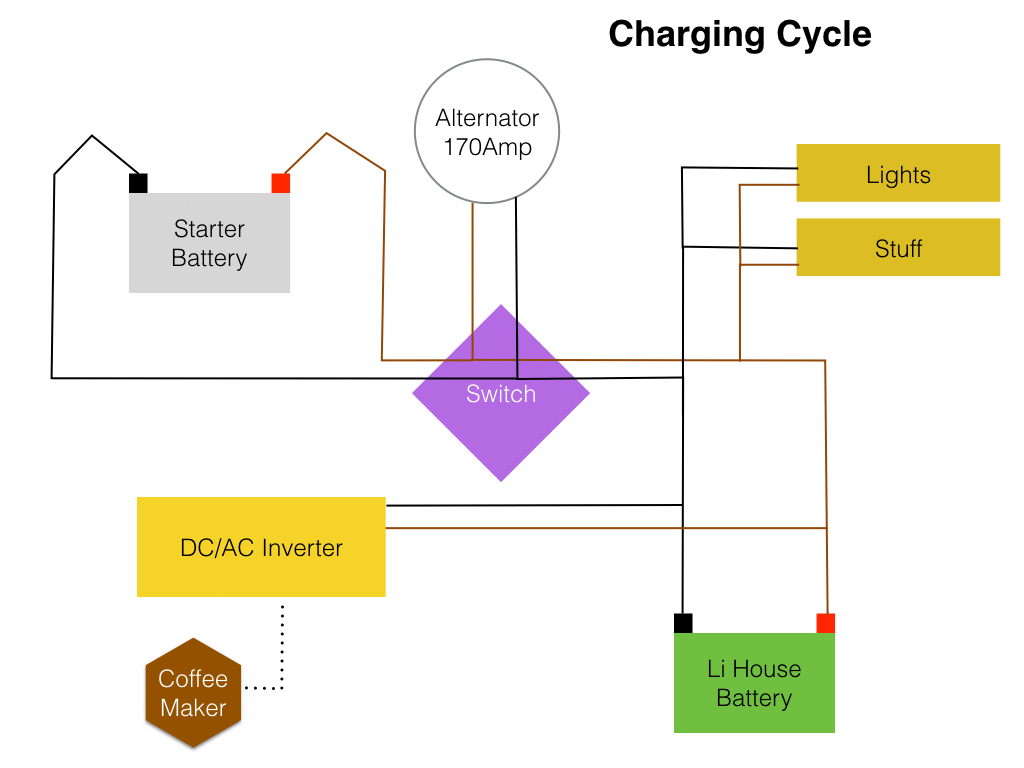I've read every thread I can find here and on other forums for the past two months, and there is very little on the topic of running a dual battery setup with a combination of lead acid starter battery and Lithium house battery. I have in fact not found a single example of what I'm trying to do, and that surprises me. Perhaps barring some Redac systems in Australia that I still can't find any actual details on.
I've found intrepid souls that have gone 100% lithium and designed very intricate and amazing systems from scratch.
I've found people who talk trash about lithium until they're blue in the face.
I've seen comparisons of amp hours, watt minutes, unicorn farts, voltage drops, charge times, impedences, leprechaun sizes, Cs (capacity, degrees and Coulomb, not the speed of light), heat tolerance, 12,24,48,96,192,384 and 6144 volts (maybe not quite), and I'm done with all of that.
We're going lithium for our second battery in our dual battery setup - this thread isn't about choosing if that's a good idea.
I would like to discuss the difference between the two possible ways of charging the Li battery - simply put, should we use an inverter and a battery charger for the Li battery, or just do the simple alternator isolator system and treat the Li battery like a lead acid?
The manufacturer of our particular battery suggests their Li batteries are "‘plug-and-play’ replacement modules for lead acid applications." But then I see things like this LiFePo charger from Redarc in Australia, and wonder if I still need something like that since these batteries have built in BMS? The Redarc charger implies that the charger is still needed even if a battery has BMS, but is that old information? I haven't called Redarc yet, but plan to.
Since I like to draw pictures in order for me to understand something better, I'm looking for pros and cons specific to the performance of the two options pictured below (I know one system is going to cost more). I drew in the positive and negative legs for each run just so my simple mind could follow the flows. I know that ultimately where you ground can be different and only the positive lead really needs to be switched, but I'm semi-feable, so bear with me...
Standard dual battery setup:

AC Charger dual battery setup:

In the interest of making this thread easy for others to find in the future, here are some key words I've used to find information:
dual battery, lithium, LiFeMgPO4, LiPo, lithium iron, LiFePo, charger, alternator, inverter, lead acid, agm, Ahr, amp hour, bms, battery management, isolator, dc-dc
I've found intrepid souls that have gone 100% lithium and designed very intricate and amazing systems from scratch.
I've found people who talk trash about lithium until they're blue in the face.
I've seen comparisons of amp hours, watt minutes, unicorn farts, voltage drops, charge times, impedences, leprechaun sizes, Cs (capacity, degrees and Coulomb, not the speed of light), heat tolerance, 12,24,48,96,192,384 and 6144 volts (maybe not quite), and I'm done with all of that.
We're going lithium for our second battery in our dual battery setup - this thread isn't about choosing if that's a good idea.
I would like to discuss the difference between the two possible ways of charging the Li battery - simply put, should we use an inverter and a battery charger for the Li battery, or just do the simple alternator isolator system and treat the Li battery like a lead acid?
The manufacturer of our particular battery suggests their Li batteries are "‘plug-and-play’ replacement modules for lead acid applications." But then I see things like this LiFePo charger from Redarc in Australia, and wonder if I still need something like that since these batteries have built in BMS? The Redarc charger implies that the charger is still needed even if a battery has BMS, but is that old information? I haven't called Redarc yet, but plan to.
Since I like to draw pictures in order for me to understand something better, I'm looking for pros and cons specific to the performance of the two options pictured below (I know one system is going to cost more). I drew in the positive and negative legs for each run just so my simple mind could follow the flows. I know that ultimately where you ground can be different and only the positive lead really needs to be switched, but I'm semi-feable, so bear with me...
Standard dual battery setup:

AC Charger dual battery setup:

In the interest of making this thread easy for others to find in the future, here are some key words I've used to find information:
dual battery, lithium, LiFeMgPO4, LiPo, lithium iron, LiFePo, charger, alternator, inverter, lead acid, agm, Ahr, amp hour, bms, battery management, isolator, dc-dc
